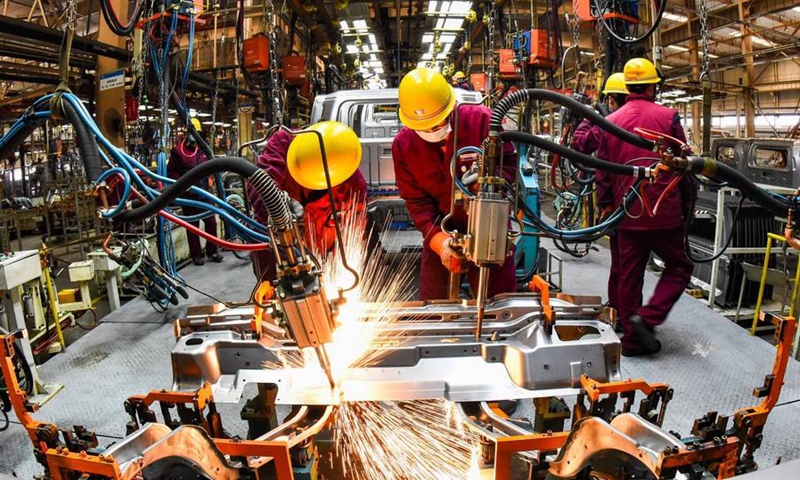China reported better-than-expected economic data in the first two months of the year, underpinning hope that the world’s second largest economy is steadily marching forward on a path to recovery despite economic headwinds ahead, experts told the Global Times.
In the first two months of this year, industrial production rose 7.5 percent year-on-year, accelerating 3.2 percentage points compared with December last year, data released by the National Bureau of Statistics (NBS) revealed on Tuesday. The growth figures beat wide market expectations around 2 to 4 percent.
The country’s services production index grew by 4.2 percent on a yearly basis, up 1.2 percentage points compared with December last year.
Market sales performance continued to gain steam. Retail sales expanded 6.7 percent year-on-year to 7.44 trillion yuan ($1.17 trillion), an increase of 1.2 percentage points from December. Market expectations generally stood at 5 percent citing weak consumption demand stemming from the pandemic and soaring oil prices.
Cong Yi, dean of the School of Marxism at Tianjin University of Finance and Economics, told the Global Times on Tuesday that the retail boost on a month-on-month level reflected the stability of social consumption.
The “stay put” orders issued during the Spring Festival drove tourism and catering within major cities, and many places introduced supportive policies such as consumer coupons aimed at boosting consumer spending.
Fixed-asset investment shot up by 12.2 percent to 5.08 trillion yuan, with infrastructure investment up 8.1 percent on a yearly basis. Real estate development investment increased by 3.7 percent year-on-year.
“The acceleration of infrastructure investment has become the most obvious sign of the efforts of macro policies to stabilize growth this year, and its driving effect has been reflected in the economic data,” said Cong.
China’s policy toward stabilizing investment has been put in force since December last year, since then the growth rate of investment has shown an upward trend.
China’s top economic planner announced in January that it will moderately front-load infrastructure investment and steadily push forward the 102 mega projects earmarked for the 14th Five-Year Plan period (2021-25) to achieve concrete results.
Despite a new wave of COVID-19 flare-ups in multiple cities and regions across the country, which will likely weigh on economic activity, its impact on the overall economic growth should not be exaggerated, experts said.
Cong estimated that the first-quarter economic indexes will not be severely affected by the pandemic given the better-than-expected data of the first two months and China’s extended experience in dealing with the virus.
“As uncertainties hang over the recent virus outbreaks in several Chinese cities, time is needed to observe its impact. But China’s economy has the resilience and potential to maintain stable development. The country also has rich experience in preventing the virus’ spread,” an NBS official told the press conference on Tuesday.
The direct impact of Russia-Ukraine tensions on Chinese economy is limited as trade with the two nations accounts for a small share in China’s total trade. As bulk commodity price soars, inflation pressure is heating up and China will ensure stabilizing energy supply, the official said.
China’s GDP expanded 8.1 percent in 2021, growing the fastest in nearly a decade and landing well above the government’s annual target of achieving a growth rate above 6 percent. The robust expansion of which eclipses most of other major economies in two-year terms, and it has spelt out a steady economic recovery path building upon the country’s dynamic zero-tolerance epidemic strategy that the Chinese government has been unswervingly holding onto regardless of Western slandering and headwinds.
China set its GDP growth target of around 5.5 percent in 2022, projecting policymakers’ confidence in the resilience of the world’s second-largest economy even as they warned of “many more risks and challenges” this year.
Chinese Premier Li Keqiang on Monday stressed the importance of efforts to tide over difficulties to ensure steady economic growth while presiding over an executive meeting of the State Council.
China’s economic work this year will prioritize stability while pursuing progress, with all regions and government departments required to assume responsibility for stabilizing the macro economy, while also taking the initiative and launching policies conducive to economic stability, according to the annual Central Economic Work Conference last December.
The conference has cautioned that China’s economic development is facing pressure from demand contraction, supply shocks and weakening expectations, and the external environment is becoming increasingly complicated, grim and uncertain.
Workers weld components at a workshop of an automobile manufacturing enterprise in Qingzhou City, east China’s Shandong Province, Feb. 28, 2021.(Photo: Xinhua)




